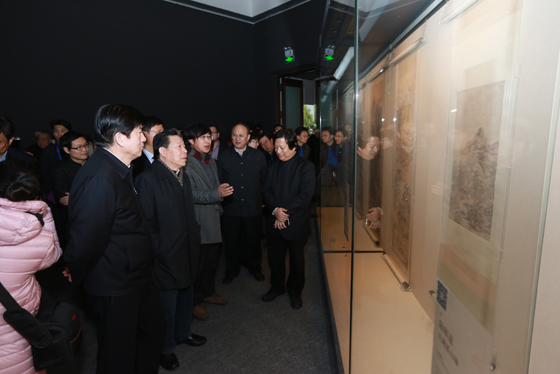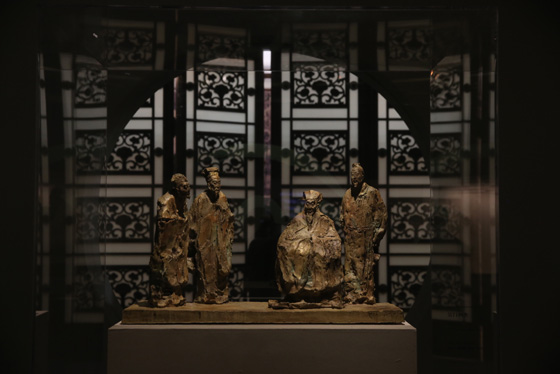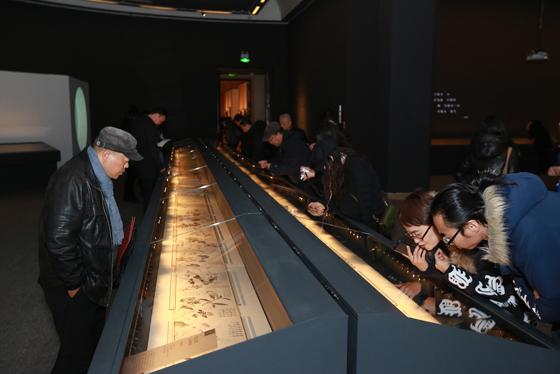Artworks of Wu School in Ancient and Modern times: A Dialogue across Time and Space
Source:: Time:2017年12月25日
In order to celebrate the successful convening of the Nineteenth National Congress of the CPC, the National Art Museum of China (NAMOC), Publicity Department of the CPC Jiangsu Provincial Committee, Jiangsu Provincial Federation of Literary and Art Circles and Suzhou Municipal People’s Government co-hosted a special art exhibition of “Looking Back 600 Years—Special Painting Exhibition from Four Great Artists of Ming Dynasty to the Contemporary Wu School”, which welcomed its grand opening at NAMOC on November 30, 2017.
There are 164 paintings exhibited in the show, including Chinese paintings, oil paintings, woodblock printings, watercolors, etc. These artworks are divided into three groups by their creation time. They fall into the following three categories: 1) Ancient Artworks: consisting of 29 sets of 71 pictures, borrowed from the Palace Museum, and including the classic works of the “Four Wu School Initiators”, the later generation of artists of Wu School—represented by Dong Qichang and “Four Wang-surnamed Artists”—all of them were influential figures in the history of Chinese paintings; 2) Modern Artworks: 18 paintings selected from the collections of NAMOC, Jiangsu Academy of Chinese Paintings, Suzhou Academy of Chinese Paintings, Suzhou Guwuxuan Publishing House and private collectors, most of which are the best works of Wu Hufan, Yan Wenliang and other representative artists of Suzhou that have pioneered and explored in the transformation of modern painting history; and 3) Contemporary Artworks: 75 paintings, including 35 original award-winning works or finalist works from national arts contests with other 40 paintings chosen as exhibits after expert reviews.
In this show, the ancient classic artworks are exhibited in the No. 1 Exhibition Room. In the semicircle lounge behind it, visitors can see the chronicles and chronology related to art in Suzhou in the past 600 years, as well as the representative works of modern artists from Suzhou, presenting a full chapter of Suzhou painting history throughout the past 600 years. The excellent artworks by contemporary painters from Wu School, exhibited in Exhibition Hall No. 8 and No.9, further add Suzhou-style touch of the exhibition and display approaches.
General Secretary Xi Jinping points out in Report of the Nineteenth National Congress of the CPC: “We will draw on China’s fine traditional culture, keep alive and develop its vision, concepts, values, and moral norms, and do so in a way that responds to the call of our era. With this we will see that Chinese culture maintains its appeal and evolves with the times”. Suzhou, which is 2,500 years old, is a world-famous old city drenched in culture. In the past 600 years, Suzhou even became a core city of agribusiness, fishery, industry and commerce-based economy in China, as well as an important city of culture and art, featuring great comprehensive power, full categories and sustained development. The arts creation of Suzhou has been playing a very important role in China’s history of fine arts. The Wu School of Painting, which was initiated by Shen Zhou, Tang Yin, Wen Zhengming and Qiu Ying in the Ming Dynasty, was one of the biggest, most successful and influential schools of painting in China’s history of fine arts. The “Wu School of Painting” was best characterized by its inclusivity as it advocated both the arts style before the Song and Yuan Dynasties, and the arts style of Zhejiang and the style dating back to Southern and Northern Song Dynasties, which were widely criticized by the public then. What’s more praiseworthy was that they were not limited by traditions and remained quite creative based on the observation of nature, making a great artistic achievement in the development of Chinese civilization and laying the foundation for Suzhou’s historical position as an important city of Oriental Culture.
From the late Ming Dynasty onwards, the heritage of “Wu School of Paintings” continued throughout the times. Dong Qichang was the first one to link up with the “Wu School” of the Ming Dynasty and created the “Songjiang School” featuring new literal paining style. After that, Wang Shimin, Wang Jian, Wang Hui and Wang Yuanqi sprang up in Taicang, Changshu and other places within the jurisdiction of Suzhou and Songjiang, thereby forming painting school of Four Great Artists. They inherited the style of Dong Qichang and “Songjiang School”, but also carried forward the traditions of orthodox literal paintings, as they aimed to follow the pattern of ancient painting style, focused on bringing out the delight of ink and pursued the implications of literal paintings. With different focuses on inheritance, Wang Shimin and Wang Yuanqi created the “Loudong School” while Wang Jian and Wang Hui were the founders of “Yushan School”. Both schools had their inheritors. Their artworks were favored by the rulers of Qing Dynasty and their arts style was widely spread as the formal and orthodox school in the royal academy of fine arts of the Qing Dynasty. There are also many followers so that the influence continued until the late Qing Dynasty and the early period of the Republic of China (1912-1949).
From 1895 to 1949, or the period throughout the late Qing Dynasty and the Republic of China (1912-1949), the painters of Suzhou plunged into setup of associations freely. There were over 20 painting associations or societies there, making great contributions to the formation of the Shanghai-style art. In addition, many artists from Suzhou blended in the arts circle of Shanghai, carrying on the traditions of hosting elegant gatherings with the artists of “Wu School of Paintings”. On one hand, the associations of fine arts, represented by Yi Garden Painting Association, Taowu Painting Society, Suoluo Painting Society and so on, rose and thrived to sustain the traditions of literal paintings; on the other hand, oil paintings, pastels and watercolors took root and gradually blossomed there. In 1922, particularly, Yan Wenliang and other artists actively responded to the new trend of the era, and founded Suzhou College of Fine Arts, followed by establishing arts museum, hosting arts contests and fostering a lot of fine arts talents. He blazed the education and creation paths for Western-style paintings in modern China along with Xu Beihong, Liu Haisu and Lin Fengmian.
After the founding of the People’s Republic of China, Suzhou paintings leveraged their own conditions to ride the wave, changing and evolving under the new context of the era. In 1960, Suzhou Museum of Chinese Paintings (later renamed as Suzhou Academy of Chinese Paintings) was set up in Suzhou, with Zhang Xinjia as its first president. In the development of new-style Chinese paintings, which aimed to reflect the real life with traditional arts style, Yu Tongfu, Zhang Jin, Fei Xinwo, Zhang Xinjia, Wu Xiangmu, Xu Shiming and other artists from Suzhou came to the fore, and made great achievements.
The reform and opening-up bring about new chances and challenges to the art circles of Suzhou. The painting styles are increasingly diversified as Chinese paintings, oil paintings, woodblock printings, pastels, etc. blossomed together. The old artists were reenergized with new creation ideas, while mid-aged and young artists continued to rise. Zhang Jixin, Sun Junliang, Zhou Jumin, Xu Huiquan, etc. created representative artworks of this period. They had combined classic traditional arts contents with fresh modern aesthetics, developing the new arts style for the paintings of flowers, landscape and figures, as well as those of contemporary Wu School, bringing to life the artistic traditions of Wu School of Paintings in the fertile cultural and arts land of Suzhou. In these years particularly, the artists of Suzhou got the awards of “Art Exhibition in Nanjing” in addition to many other national-level prizes of fine arts. The art circle of Suzhou really ushers in the grand time of fine arts characterized by emerging talents, excellent artworks in endless stream, great development of various painting styles and unprecedented prosperity artwork creation.




